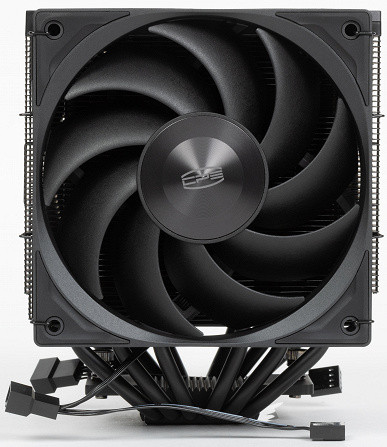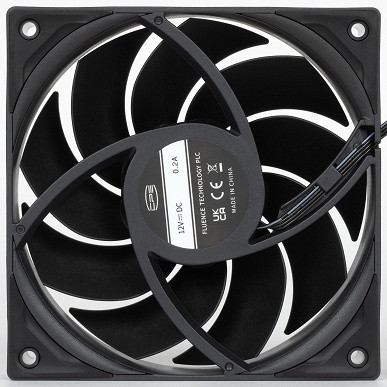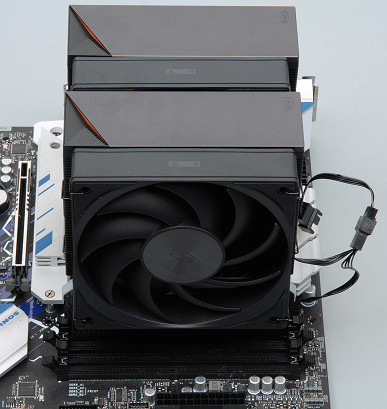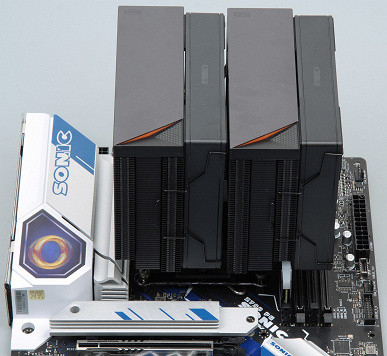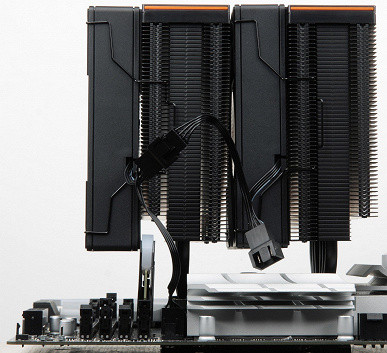Passport specifications, delivery set
| Manufacturer | PCCooler |
|---|---|
| Model name, link | RZ620 BK |
| Model code | RZ620-BKNWNX-GL; EAN: 6940526113300 |
| Cooling system type | for the processor, air tower type with active blowing of the radiator located on heat pipes |
| Compatibility | motherboards with processor sockets: Intel: LGA115X/1200/ 1700/18XX ; AMD: AM5/AM4 |
| Cooling capacity | no data |
| Fan type | axial, 2 pcs. |
| Fan model | no data |
| Fan power supply | 12V, 0.23A |
| Fan dimensions | 120×120×25 mm |
| Fan speed | 1800/500—2000/2200 rpm |
| Fan performance | 116.6/132.7/147.4 m³/h (68.64/78.10/86.73 ft³/min) |
| Fan static pressure | 20.6/25.5/31.4 Pa (2.1/2.6/3.2 mm water column) |
| Noise level | 28/30/32 dBA |
| Fan bearing | hydrodynamic (FDB) |
| Fan service life | no data |
| Cooler dimensions (H×W×D) | 157.5×130×142.5 mm |
| Cooler weight | no data |
| Radiator material | aluminum plates (0.4 mm thick) and copper heat pipes (6 pcs. ∅6 mm), copper heat sink |
| Thermal interface of heat sink | PCCooler EX90 thermal paste in a syringe |
| Connection | Fan: 4-pin connector (power, rotation sensor, PWM control) |
| Peculiarities |
|
| Delivery set (better to check before purchasing) |
|
Description
The processor cooler is supplied in a strictly designed box made of medium-thick corrugated cardboard.
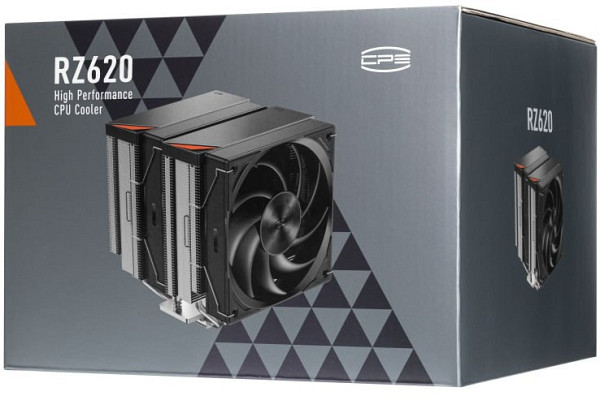
The installation instructions are presented in the form of a book-folding accordion of good printing quality. The main information is presented in the form of illustrations and does not require translation. The fasteners are made mainly of hardened steel, including the frame on the back of the system board, and have a durable galvanic coating.
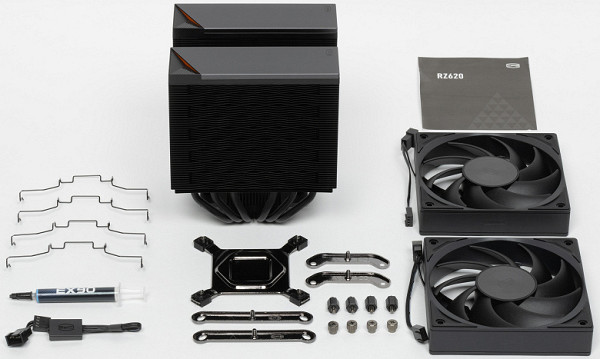
The cooler is equipped with a dual remote radiator, to which the heat from the processor is transferred through six heat pipes. The pipes and the lower part of the heat sink are made of copper. The pipes, the non-working surface of the heat sink and the radiator plates have a black semi-matte paint coating, which slightly improves heat transfer due to radiation. The upper part of the heat sink is made of aluminum alloy, and the pipes are soldered to the heat sink. The base of the heat sink has a fine concentric groove and is slightly polished, while the surface of the base is slightly convex towards the center with a difference of about 0.1 mm.
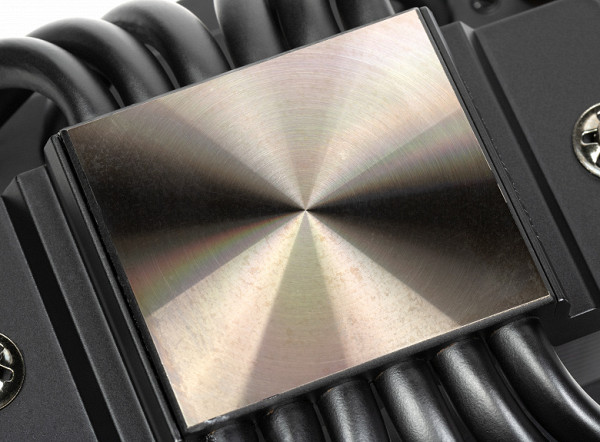
The cooler does not have a pre-applied thermal interface, but the manufacturer has attached a small syringe with thermal paste. High-quality thermal paste from another manufacturer was used in the tests. For clarity, we will later show the distribution of thermal paste after completing the tests on the Intel Core i9-13900K processor:
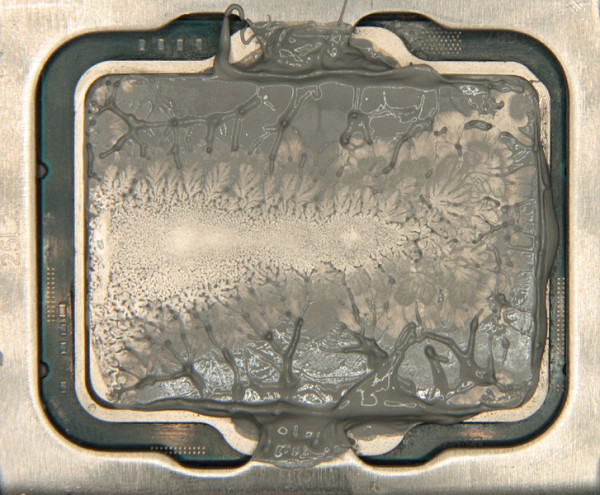
And on the sole of the heat sink:
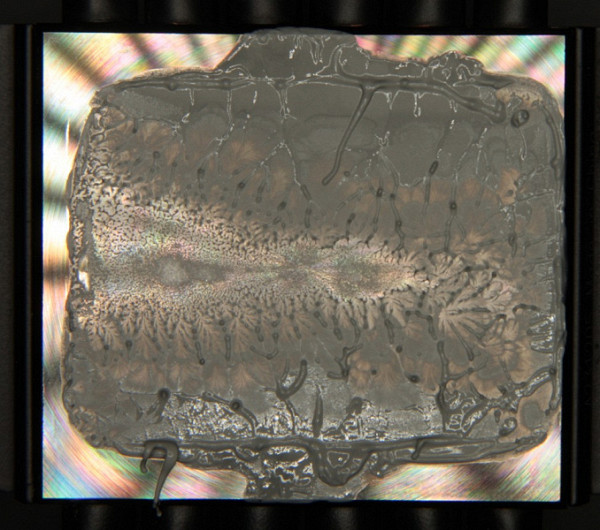
The thermal paste was evenly distributed in a thin layer over almost the entire surface of the processor cover, with the excess squeezed out along the edges, creating a significant spot of tight contact.
The radiator consists of two stacks of aluminum plates that are tightly mounted on heat pipes. From above, these stacks are covered with decorative covers.
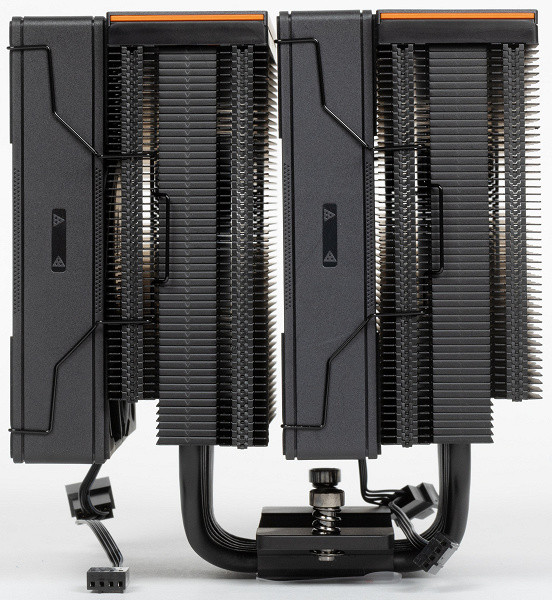
The standard size of the supplied fans is 120 mm.
The fans are mounted with typical steel brackets. The fans support PWM control.
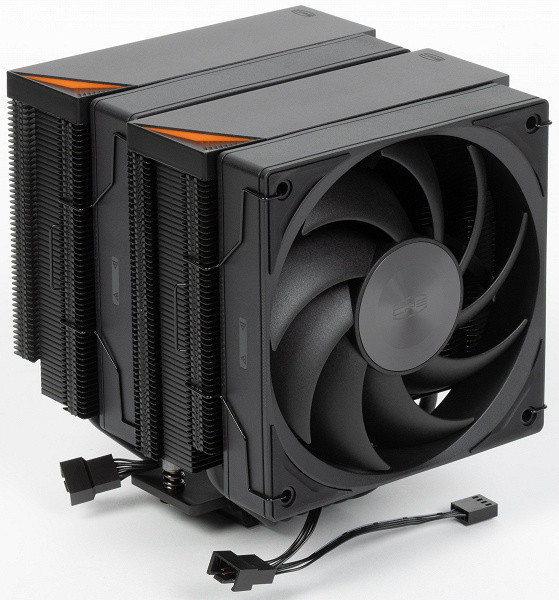
The cooler comes with an extension cord with a regulator.
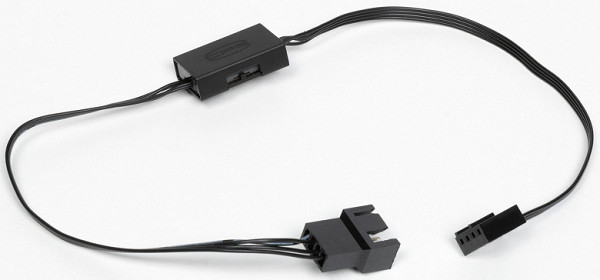
The switch on the regulator has three positions.
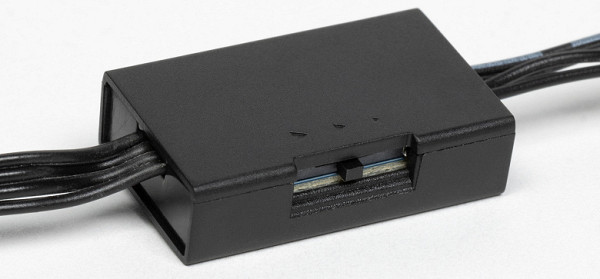
However, on the radiator, some of the fins have a reduced depth, and the external fan can be raised, which, according to our measurements, allows using memory modules up to 57 mm high in all slots.
It should be noted that the design of the fasteners prevents both insufficient and excessive pressure (it is enough to simply tighten the nuts to the stop without excessive force), and also reduces the risk of distortion thanks to the two-point pressure.
Testing
Below in the summary table we present the results of measurements of a number of parameters.
| Cooler weight (with mounting kit for LGA1700), g | 1412 |
|---|---|
| Weight of radiator only, g | 928 |
| Dimensions of heat sink platform, mm | 41×36 |
| Fan power cable length, cm | 13.5 (to the feed-through connector — 4.0) |
| Fan power extension length, cm | 31 |
Determining the dependence of the cooler fan speed on the PWM duty cycle and/or supply voltage
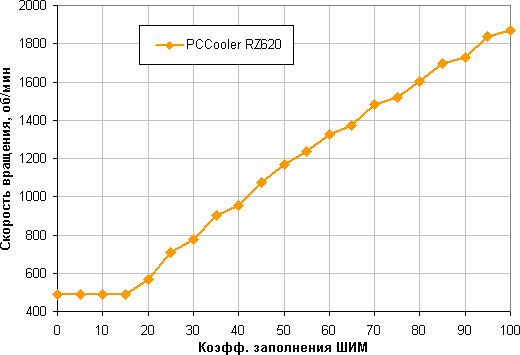
Good results are demonstrated by a uniform increase in rotation speed when changing the fill factor (FF) from 15% to 100% and a wide adjustment range. It is worth noting that at FF 0% the fan does not stop. Thus, in a hybrid cooling system with a passive mode at minimum load, such fans will need to be stopped by reducing the supply voltage.
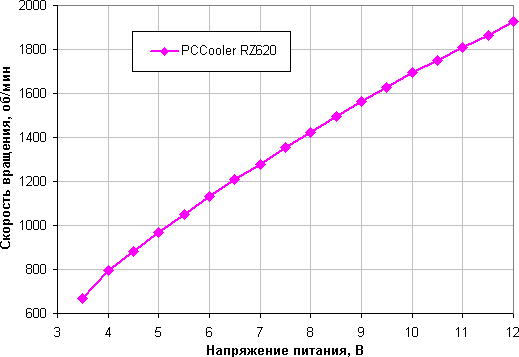
Good results are demonstrated by a uniform increase in rotation speed when changing the fill factor (FF) from 15% to 100% and a wide adjustment range. It is worth noting that at FF 0% the fan does not stop. Thus, in a hybrid cooling system with a passive mode at minimum load, such fans will need to be stopped by reducing the supply voltage.
Determining the dependence of the temperature of the Intel Core i9-13900K processor at full load on the rotation speed of the cooler fan(s)
In this test, all cores of the Intel Core i9-13900K processor operated at 3.7 GHz.
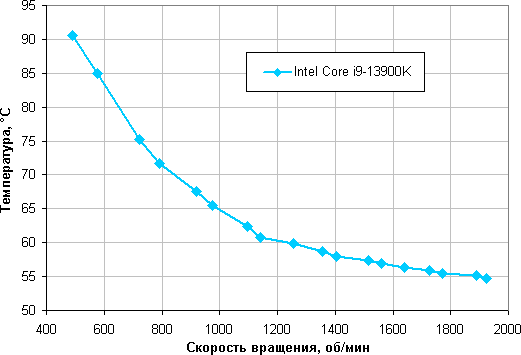
In this test, the Intel Core i9-13900K processor does not overheat (at an ambient temperature of 24 degrees) at fan speeds achieved with a fill factor of 20%, which corresponds to about 580 rpm. The maximum consumption, according to monitoring data, was about 157 W, while according to the processor power connectors — 194 W. For comparison, the base power of this processor is only 125 W, and the standard maximum short-term (turbo limit) is 253 W.
Determining the noise level depending on the rotation speed of the cooler fan(s)
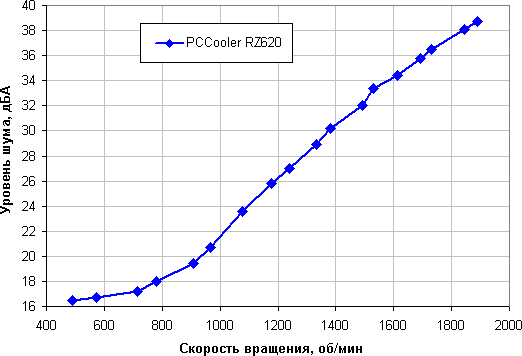
The noise level of coolers depends on individual characteristics and other factors, but in the case of desktop systems, noise from 40 dBA and above can be considered high. The level from 35 to 40 dBA is considered tolerable, while the sound below 35 dBA will not stand out significantly against the background of ordinary PC components — case fans, power supply, video card and hard drives. With noise below 25 dBA, the cooler can be considered relatively silent. The background noise level was 16.2 dBA, which is a conditional value according to the sound meter readings.
Plotting the dependence of the actual maximum power on the noise level
Let's try to move from the test bench conditions to more realistic scenarios. Let's assume that the air temperature entering the cooling system fan can reach 44 °C, while we want to keep the processor temperature under maximum load below 80 °C. Having established these conditions, we can plot the dependence of the real maximum power (designated as Pmax, previously we used the designation Max. TDP) consumed by the processor on the noise level.
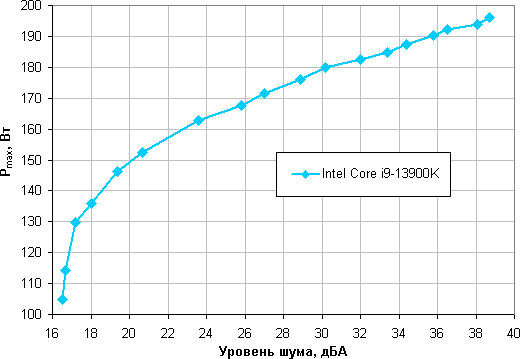
Taking 25 dBA as the criterion of conditional silence, we can determine the approximate maximum power of processors such as the Intel Core i9-13900K, corresponding to this level, which is about 165 W. Hypothetically, ignoring the noise level, the power limits can be increased to about 195 W. We remind you that this is assumed under strict conditions of blowing air over the radiator heated to 44 degrees, and a maximum processor temperature of 80 ° C (in principle, up to 100 ° C is permissible). With a decrease in air temperature or an increase in the maximum permissible processor temperature, the specified power limits for silent operation and maximum power may increase.
Conclusions
To correctly understand the conclusions, it should be taken into account that the purpose of testing is primarily to determine the cooling capacity of the cooler (or liquid cooling system). The processors used in the tests serve exclusively as a heating element for the subsequent assessment of the conditional thermal resistance of the cooler in various modes. Thus, the power (heat dissipation) of the processor is artificially adjusted to match the capabilities of the cooling system; it can be both lower and higher than the standard operating modes of the processor. The main thing is that in the range of the cooling capacity of the cooler, the processor does not overheat (at least at 25 dBA), and that there is a noticeable difference in the change in the temperature of the processor. Based on the PCCooler RZ620 BK air cooler, you can assemble a relatively silent computer (noise level of 25 dBA and below) with a processor such as the Intel Core i9-13900K, provided that its consumption under maximum load does not exceed 165 W, and the air temperature inside the case does not rise above 44 ° C, with a maximum processor temperature limit of 80 ° C. By reducing the cooling air temperature, increasing the permissible processor temperature (up to 100 ° C) or less strict requirements for the noise level, you can increase the power limits. Among the advantages of the cooler, we can highlight the neat design, and among the disadvantages — limited compatibility with high memory modules.

